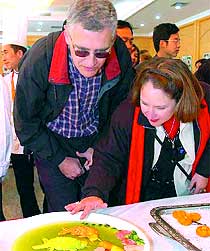Thanks to its high mountains, elegant rivers, springs and waterfalls, rich and varied folk customs and styles, rare animals and plants, numerous scenic spots and historical sites, distinctive operas, music and dances, and its world-renowned cuisine, China attracts a large number of domestic and foreign tourists every year. In 2001, nearly one million visitors from the United States alone came to China, according to statistics available from the China National Tourist Office. Most travelers were from Japan, followed by the Republic of Korea, Russia and then the United States. (Great Britain was 9th; Australia, 11th.) And although not all of those people were tourists—some were in China on business or attending conferences or visiting families—most needed travel services somewhere along the line. In response, China has formed the largest domestic tourism market in the world and an outbound tourism market with the highest rate of growth in the world. The World Tourism Organization predicts that by 2020 China will be the No.1 tourist destination in the world and will rank fourth in the number of Chinese tourists traveling abroad in the world.
In 2002, tourism income came to 556.6 billion yuan, or an increase of 11.4 percent over that of the previous year, and 3.4 percentage points higher than the overall growth rate of the national economy. Foreign exchange earnings generated by tourism reached 20.4 billion US dollars, or a raise of 14.6 percent over 2001. Outbound tourism—Chinese citizens traveling to other countries—also grew. In 2002, a total of 16.6 million Chinese people traveled abroad, an increase of 36.8 percent over that of the previous year. Domestic tourism has been growing in a sustained way, and both tourists and tourism earnings grew by more than 10 percent over those of the previous year.
Tourist Services
China has worked hard in recent years to meet the demands of tourists by building, expanding and renovating many hotels and restaurants. By the end of 2001 (the latest statistics available at press time from the China National Tourism Administration) in China there were 11,000 hotels, among which some 7,300 were star-rated hotels; there were some 260,000 travel companies, including more than 10,000 tour operators or travel agencies. Some 5.8 million people were employed directly in the travel industry, while indirect employments related to the travel industry reached 29 million and there were 1,152 tourism colleges or schools, and the number of all students reached 340,000. All large and medium-sized cities and tourist sites have hotels with complete facilities and excellent services for domestic and international tourists. Rapid progress also has been made in civil aviation, railways, inland and marine transport, and highways, providing guarantee and convenience for both Chinese and foreign tourists traveling in China. In January 2002, American Express and China International Travel Service (CITS) announced the establishment of CITS American Express Travel Services Limited, the first Sino-US business travel joint venture in the People's Republic of China between the largest travel service in China and American Express — one of the 500 top enterprises in the world. At present, 11 jointly-owned Chinese-foreign travel services have been established. According to China's commitments within the WTO, before January 1, 2003, foreign travel agencies were permitted control (by holding over 51 percent of shares) of joint-venture travel agencies. Before December 31, 2005, solely foreign-owned travel agencies can operate in China.
Tourist Themes
The Chinese tourist industry is well equipped to host group tours of major tourist destinations in places like Beijing, Xi'an, Shanghai, Suzhou, Hangzhou, Guilin and Guangzhou. But in recent years, the industry also has begun to introduce specialty and other tours of interest to groups like hikers, bicyclists, birders, and others. On the CNTA website travelers are given information on rock climbing events and are invited to contact China International Travel Service about cycling, hiking, exploring the deserts, mountain climbing, skiing, golfing, and a martial arts and fitness tour. Ecotourism combines activities like bird watching, boating, and enjoying traditional ethnic foods, customs, and culture. Home stays in a local village are a popular part of the ecotourism tours in northwest Yunnan Province sponsored by the American non-governmental organization, Nature Conservancy, in cooperation with local Yunnan governments. Travelers also can combine study with pleasure as in the Yangtze River tours that CNTA is promoting as a chance for visitors not only to view the stunning natural scenery but to learn first-hand about the remarkable Three Gorges Project, the largest dam in the world.

To better introduce China's tourist resources to domestic and foreign tourists, the China National Tourism Administration has promoted a tourism theme per year. The year of 1992 was "Friendly Sightseeing Year," which was followed by the "Landscape Tour," "Tour of Cultural Relics and Historical Sites," "Folk Customs Tour," "Holiday Tour," and "Ecological Environment Tour." From 2000 to 2002, the tourism themes were "Century Tour," "Health & Fitness of China," and "Folk Arts of China." The tourism theme for 2003 is "Culinary Kingdom," aimed at helping tourists better understand how extensive and profound and enduring Chinese culinary culture is while they visit scenic spots and historical sites in China. In accordance with the plan of the China National Tourism Administration, the theme of 2004 will be "Catch the Lifestyle."

